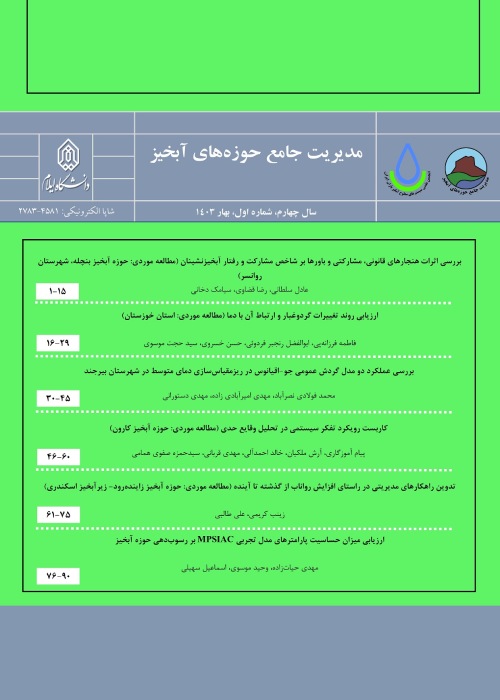Zoning of soil erodibility and determination of affecting factors (Case study: Golan watershed, Ilam)
Extended abstractIntroductionSoil serves as the foundation for all human productive activities, and the rise and fall of numerous great and ancient civilizations can be attributed to the fertility and preservation of soil. Some civilizations have experienced downfall due to inadequate productivity and failure to sustain natural resources. Erosion can be classified into two main categories: geological erosion, which can lead to soil formation and accelerated erosion, which causes soil degradation. The study of erosion is of great significance. For instance, Asia currently faces a concerning erosion condition, while Africa is experiencing a highly dangerous level of erosion. Erosion is a globally destructive phenomenon, particularly water erosion, which directly and indirectly impacts human life by depleting fertile agricultural soils. In order to determine appropriate protective measures, it is crucial to assess the level of erosion in a given area. Thus, evaluating the severity of erosion becomes an essential task. This study aims to examine the erosion and sedimentation status in the Golan watershed of Ilam province, as well as determining the current state of soil erosion and sediment yield.Methodology The study focuses on Golan watershed in Mehran city, Ilam Province, which spans an area of 78.87 km2. To conduct this research, the following methodology was employed. First, a topographical map on a scale of 1:50000 and aerial photos of the area were obtained. The topographic map was used to delineate the boundaries of the study area, while the aerial photos aid in understanding the natural features and assist in dividing the area into hydrological units. Next, Relevant information and statistics from previous studies related to the study area were collected. This data provide valuable insights and contribute to the analysis. Then, Base maps were prepared within a ArcGIS environment. These base maps include geological maps, soil types, vegetation cover, slope, direction, elevation classes, and other pertinent factors. To enhance accuracy, the base maps were verified in the field, and the necessary parameters for estimating erosion and sedimentation were scored through field surveys. After that, the MPSIAC model was utilized to estimate erosion and sedimentation. By inputting the collected data and factors derived from the base maps into the model, erosion and sedimentation rates were estimated. The model will help assess the vulnerability of the study area to erosion. Finally, Based on the estimations from the MPSIAC model, an erosion map was prepared. This map depicts the areas prone to erosion within the study area, providing valuable information for land management and erosion control strategies. By following this methodology, the research aims to evaluate erosion and sedimentation rates in the study area and generate an erosion map that can assist in effective land management and erosion prevention measures.Results In the Golan region, various types of erosion were observed, indicating the influence of different factors with varying intensities. These erosion factors can be categorized into two groups: natural factors and human-induced factors. The rocks in the study area were classified into five erosive groups. The geological factor score for the entire area was determined to be 6.15 based on the sensitivity map of rocks in the sub-areas. The soil factor score was calculated to be 3.71. Furthermore, the climate factor score was 17.8, the runoff factor score was 13.01, the topography factor score was 10.44, the land cover factor score was 9.62, the land use factor score was 15.67, the soil surface erosion factor score was 1.81, and the water erosion factor score was 15.41.Discussion and ConclusionIn terms of erosion and sedimentation, the study area fell into the high erosion class, with a sediment yield of 541.26 m3/km2/year. Field surveys identified 12 types of erosion in the watershed. By understanding the erosion factors, measures can be taken to control erosion. Based on the obtained zoning map, it is recommended to implement control and protective operations in erosive areas, while avoiding any activities or projects that may lead to accelerated erosion, such as road construction. Natural erosion occurs in nature and does not necessarily result in soil loss. However, human interventions in natural resources exacerbate erosion intensity, leading to accelerated erosion. Therefore, it is crucial to assess the intensity and types of erosion in different areas and implement appropriate planning and management measures. One proposed program to control soil erosion in the region is the implementation of land uses based on their capabilities, along with soil protection programs for agricultural lands. Additionally, techniques aimed at increasing the stability of soil grains should be considered to reduce erosion. In conclusion, understanding the factors contributing to erosion and implementing appropriate management strategies are vital to erosion control and soil conservation in the study area.
- حق عضویت دریافتی صرف حمایت از نشریات عضو و نگهداری، تکمیل و توسعه مگیران میشود.
- پرداخت حق اشتراک و دانلود مقالات اجازه بازنشر آن در سایر رسانههای چاپی و دیجیتال را به کاربر نمیدهد.



